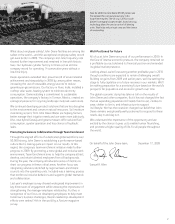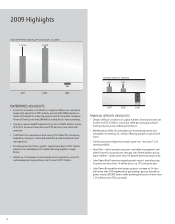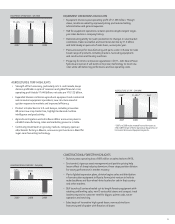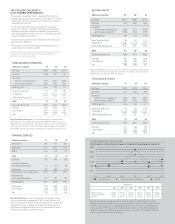John Deere 2009 Annual Report Download - page 17
Download and view the complete annual report
Please find page 17 of the 2009 John Deere annual report below. You can navigate through the pages in the report by either clicking on the pages listed below, or by using the keyword search tool below to find specific information within the annual report.
For the purpose of computing unused credit lines, commercial
paper and short-term bank borrowings, excluding secured
borrowings and the current portion of long-term borrowings,
were primarily considered to constitute utilization. Included in
the total credit lines at October 31, 2009 was a long-term credit
facility agreement of $3.75 billion, expiring in February 2012.
The credit agreement requires Capital Corporation to maintain
its consolidated ratio of earnings to fi xed charges at not less than
1.05 to 1 for each fi scal quarter and the ratio of senior debt,
excluding securitization indebtedness, to capital base (total
subordinated debt and stockholder’s equity excluding accumu-
lated other comprehensive income (loss)) at not more than
11 to 1 at the end of any fi scal quarter. The credit agreement
also requires the Equipment Operations to maintain a ratio of
total debt to total capital (total debt and stockholders’ equity
excluding accumulated other comprehensive income (loss)) of
65 percent or less at the end of each fi scal quarter according to
accounting principles generally accepted in the U.S. in effect at
October 31, 2006. Under this provision, the company’s excess
equity capacity and retained earnings balance free of restriction
at October 31, 2009 was $6,494 million. Alternatively under
this provision, the Equipment Operations had the capacity to
incur additional debt of $12,060 million at October 31, 2009.
All of these requirements of the credit agreement have been
met during the periods included in the consolidated fi nancial
statements.
Debt Ratings. To access public debt capital markets, the
company relies on credit rating agencies to assign short-term
and long-term credit ratings to the company’s securities as an
indicator of credit quality for fi xed income investors. A security
rating is not a recommendation by the rating agency to buy,
sell or hold company securities. A credit rating agency may
change or withdraw company ratings based on its assessment
of the company’s current and future ability to meet interest and
principal repayment obligations. Each agency’s rating should
be evaluated independently of any other rating. Lower credit
ratings generally result in higher borrowing costs and reduced
access to debt capital markets. The senior long-term and
short-term debt ratings and outlook currently assigned to
unsecured company securities by the rating agencies engaged
by the company are as follows:
Senior
Long-Term Short-Term Outlook
Moody’s Investors
Service, Inc. ......................... A2 Prime-1 Stable
Standard & Poor’s .................. A A-1 Stable
Trade accounts and notes receivable primarily arise
from sales of goods to independent dealers. Trade receivables
decreased by $618 million in 2009, primarily due to lower
production and shipment volumes. The ratio of trade accounts
and notes receivable at October 31 to fi scal year net sales
was 13 percent in 2009 and 2008. Total worldwide agriculture
and turf receivables decreased $354 million and construction
18
and forestry receivables decreased $264 million. The collection
period for trade receivables averages less than 12 months.
The percentage of trade receivables outstanding for a period
exceeding 12 months was 4 percent and 2 percent at October
31, 2009 and 2008, respectively.
Stockholders’ equity was $4,819 million at October 31,
2009, compared with $6,533 million at October 31, 2008.
The decrease of $1,714 million resulted primarily from a
retirement benefi ts adjustment of $2,537 million and dividends
declared of $474 million, partially offset by net income of $873
million, a change in the cumulative translation adjustment of
$327 million and an increase in common stock of $62 million.
EQUIPMENT OPERATIONS
The company’s equipment businesses are capital intensive and
are subject to seasonal variations in fi nancing requirements for
inventories and certain receivables from dealers. The Equipment
Operations sell a signifi cant portion of their trade receivables
to Financial Services. To the extent necessary, funds provided
from operations are supplemented by external fi nancing sources.
Cash provided by operating activities of the Equipment
Operations during 2009, including intercompany cash fl ows,
was $1,425 million primarily due to net income adjusted for
non-cash provisions and a decrease in inventories and trade
receivables, partially offset by a decrease in accounts payable
and accrued expenses.
Over the last three years, these operating activities,
including intercompany cash fl ows, have provided an aggregate
of $6,478 million in cash.
Trade receivables held by the Equipment Operations
decreased by $238 million during 2009. The Equipment
Operations sell a signifi cant portion of their trade receivables
to Financial Services (see previous consolidated discussion).
Inventories decreased by $645 million in 2009 primarily
refl ecting the decrease in production and sales. Most of these
inventories are valued on the last-in, fi rst-out (LIFO) method.
The ratios of inventories on a fi rst-in, fi rst-out (FIFO) basis
(see Note 15), which approximates current cost, to fi scal year
cost of sales were 23 percent and 22 percent at October 31, 2009
and 2008, respectively.
Total interest-bearing debt of the Equipment Operations
was $3,563 million at the end of 2009, compared with $2,209
million at the end of 2008 and $2,103 million at the end of 2007.
The ratio of total debt to total capital (total interest-bearing
debt and stockholders’ equity) at the end of 2009, 2008 and
2007 was 43 percent, 25 percent and 23 percent, respectively.
Property and equipment cash expenditures for the
Equipment Operations in 2009 were $788 million, compared
with $773 million in 2008. Capital expenditures in 2010 are
estimated to be approximately $850 million to $900 million.
During 2009, the Equipment Operations issued $750
million of 4.375% Notes due 2019 and $500 million of 5.375%
Notes due 2029. The Equipment Operations also retired
$56 million of 8.95% Debentures due 2019.
17
























